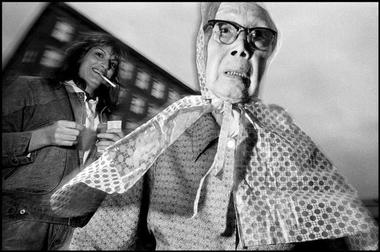KS3/4 Lesson Plan:
Cameras at the ready... Responses with attitude and the work of Bruce GildenFrom Chris Francis, St Peter's School
I have used this activity with both Year 10 and Year 12 students as a playful introduction to a whole range of ideas and skills. Here are some questions to lead students in:
- If I want to take a stranger's photo, do I have to ask them? - How should a photographer behave? - Does a street photographer move with rhythm? - Is it more acceptable to sneak a photo of someone without them knowing, or just to pounce out at them? - Would a street photographer who has grown up in Brooklyn, New York work differently to someone who has grown up in rural England (such as Martin Parr)? If so, why? This short video of Bruce Gilden at work is a great prompt for discussing some of the questions above.
Practical Activity: Bustle...Pounce!
This can be a lively ice-breaker for a new group as well as an introduction to the 'physicality' of taking photographs - thinking about how a photographer might respond rapidly with a stretch, crouch, spring, sneak, surprise, or a change of direction. It's also a great way to get to know your camera better.
You will need...
-At least one camera shared between every 3 or 4 students (although ideally each student will have a camera of sorts. Mobile phones will do).
- To mark out a space for the activity. (I've done this both inside and outside - tables cleared out of the way and masking tape on the floor; or alternatively - for a larger group - a centre circle on the yard). You need to define a space - one big enough for a group to 'bustle' within, yet still able to manoeuvre safely. The activity that follows can be repeated with different technical objectives too, for example, exploring panning, use of flash, aperture, or shutter speed settings.
|
"I have no ethics." Bruce Gilden "Growing up in Brooklyn with what he describes as a “tough guy” of a father, Bruce developed a love of the streets, often calling them his “second home.” But the love was more than just a simple connection — it was a creative fascination. It was the unique energy of the streets that mesmerized Bruce, an energy that can momentarily expose something inside people that generally stays hidden. Bruce made it his life’s work to capture those moments." |
Time to play...
- Create 3 groups numbering students from 1 to 3. If students are sharing cameras then you will need to identify which group will start as photographers.
Devise and explain a set of 3 or 4 quick-fire instructions to be shouting out (imagine a football training drill: "left hand down...right hand down...up and 'ead one!"). For those with cameras, these might be: CROUCH & SHOOT UPWARDS; STRETCH & SHOOT DOWNWARDS; EXTREME CLOSE UP!; PAN; POUNCE; SNEAK... and so on. Instructions can also work for those without cameras, for example: 'HALT' could mean put your hand up in front of you, the nearest person with a camera then has to grab a quick shot of this action.
Ask students to move about the space briskly, walking amongst each other. (They will feel awkward at first but should soon warm to it. Music can help liven things up, or alternatively, download some city street sounds!).
The intention is that all students move about the space and those whose turn it is to be 'active' with cameras - for example, all number 1's - have to quickly respond when instructions are shouted.
Devise and explain a set of 3 or 4 quick-fire instructions to be shouting out (imagine a football training drill: "left hand down...right hand down...up and 'ead one!"). For those with cameras, these might be: CROUCH & SHOOT UPWARDS; STRETCH & SHOOT DOWNWARDS; EXTREME CLOSE UP!; PAN; POUNCE; SNEAK... and so on. Instructions can also work for those without cameras, for example: 'HALT' could mean put your hand up in front of you, the nearest person with a camera then has to grab a quick shot of this action.
Ask students to move about the space briskly, walking amongst each other. (They will feel awkward at first but should soon warm to it. Music can help liven things up, or alternatively, download some city street sounds!).
The intention is that all students move about the space and those whose turn it is to be 'active' with cameras - for example, all number 1's - have to quickly respond when instructions are shouted.
DISCLAIMER: This might be chaos...
Still, I've found it a fun and useful way to combine thinking about how photographers work, whilst also learning new techniques. Once a set of images have been collected these can also be used to introduce basic digital editing techniques, such as converting to black and white, experimenting with contrast, or motion blurring. It is a lesson that is unpredictable, energetic, spontaneous, with lots of movement...Give it a go!





